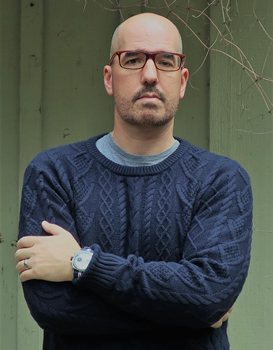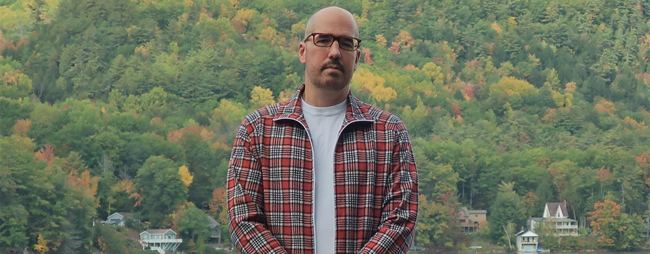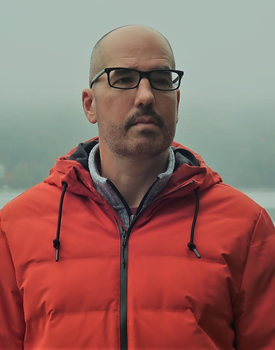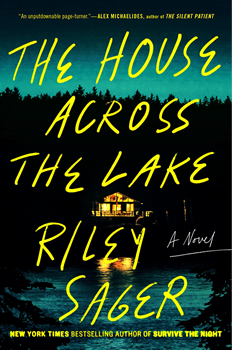A Twist You Won’t See Coming
Ever since her husband died, Casey Fletcher’s one true love has been found in a bottle, preferably bourbon. But as the tabloids have repeatedly shown, anything that sends her toppling over is a fine substitute. Once another photo spread of her getting wasted in Manhattan hits the newsstands, her mother—a beloved Broadway icon—issues an ultimatum: sober up at the family’s remote lake house or it’s straight to rehab.
Casey picks the lake house. Which seems like the logical choice…until we learn that’s where her husband drowned. The previous year. (Yikes.)
Planning on drinking the days away, courtesy of her sole neighbor, Eli, who keeps her stocked with booze in exchange for home-cooked meals, Casey settles into what she assumes will be a lazy, hazy fall. But her plan is (slightly) upended when she discovers that famous model and philanthropist Katherine Royce and her husband, Tom, have moved into the house across the lake. After saving Katherine from nearly drowning, the two quickly become friends, and Casey starts looking forward to their time together.
Casey also starts looking into the Daniels’ home with the pair of high-end binoculars her husband purchased just before his death. (Which isn’t two levels of creepy at all.)
Things could have continued this way for months—Casey hanging out with Katherine, Casey drinking herself into a nightly stupor, Casey spying on her new neighbors—but then Katherine suddenly disappears. Gone. She’s not answering her phone, all of her things are still in the house (don’t ask how Casey knows that; it’s illegal), and her husband is acting… odd.
Fortunately, Casey isn’t alone in her suspicions. A new neighbor, Boone, heard a scream the night Katherine disappeared, a scream Casey thought she’d imagined in her bourbon fog.
As the two of them try to find out what happened to Katherine, they learn that there might be a connection between Tom Royce and the several missing girls in the area.
Reader…before you think you know what’s going on, know that you’re wrong. The thing you think that happened? It didn’t. Your second guess? Also wrong. Your third will be wrong as well.
You’re never going to see what’s coming. Not at all.
And you’re going to love it.
In this exclusive interview with The Big Thrill, we poked at Riley Sager’s amazing brain to discuss his seventh book, THE HOUSE ACROSS THE LAKE, and ask him all about his writing process, where he gets his inspiration, and the much-beloved Rear Window trope.
It’s clear from references within THE HOUSE ACROSS THE LAKE that you drew on both Rear Window and The Great Gatsby. What other works influenced you in this book’s creation?

Photo credit: Michael Livio
Well, we can start with every book and movie that features a person who drinks too much, watches someone else, sees something they shouldn’t see, and then suspects foul play. It’s very, very familiar territory. There have been many variations on this story before, and there’ll be many more in the future. It’s evergreen. I chose it because I thought the pandemic was a perfect time to revisit a plot like this. I suspect a lot of readers can relate to a character stuck at home, drinking too much and staring out the window. But I also saw a lot of potential to do something new and unexpected with it. Readers who go in thinking this is just a retread of similar-sounding books are going to be very surprised.
There are other influences, of course, but to mention them would spoil some of the book’s surprises. THE HOUSE ACROSS THE LAKE is a very difficult book to talk about. I recommend going in blind, which isn’t what an author’s supposed to say when promoting a book. But in this case, it’s true. The less you know, the better.
With Lock Every Door, you had a reliable, down-to-earth main character. In THE HOUSE ACROSS THE LAKE, Casey plays up to the unreliable narrator trope. Why did you lean that way in developing her character?
I did it because this subgenre calls for it. My readers are savvy. I know they’ve read this kind of book before. I wanted to pack in as many tropes as possible, including the unreliable narrator with a drinking problem, and play around with them a little bit before taking everything in a new, crazy direction.
As for Casey, she is without a doubt the most complex character I’ve ever written. She’s lonely and troubled and an absolute trainwreck. But I also wanted her to be a likable trainwreck. Not only is she kind and caring, but she has this sardonic sense of humor that I loved writing. There’s also a bit of meta commentary to her character. Because she’s an actress who once starred in a Broadway thriller, Casey knows what kind of story she’s in—and is also aware when she’s being a cliché.

There is a very intricate weaving of Before and Now, letting us see glimpses of what’s to come for Casey without fully catching sight of the reveal. Was that something that developed organically or was it planned in from the first?
It happened well into the writing process. Because the beginning of THE HOUSE ACROSS THE LAKE required a lot of scene-setting and relationship-building before the plot fully kicked in, I always intended to start with a tantalizing hook. Nothing I wrote seemed to work, so I kept putting it off. Before I knew it, I was more than halfway done with the book. That’s when I landed on the Before and Now structure. Rather than try to be coy and mysterious, I thought it would be best to just come out and reveal in the first pages that Casey’s been watching the married couple on the other side of the lake, the wife is missing, and that Casey has the prime suspect tied up in her bedroom. We then go back and see all the events that led up to that moment—and what happens after. Once that was established, I had a lot of fun playing with that structure and building to the moment when Before becomes Now.
What was your favorite thing about writing THE HOUSE ACROSS THE LAKE?
This sounds like such a non-answer, but all of it. I think many writers have that one book they write just for themselves. They don’t think about reader expectations, how much it might sell, or how it fits into their brand. They just write the book that makes them happy. For me, THE HOUSE ACROSS THE LAKE is that book.
It had been so long since I wrote just for the fun of it. For years, there was this self-imposed pressure to improve my writing, create bigger twists, outdo myself, and hopefully, sell more copies than my previous books. It wasn’t good for me mentally, physically, or career-wise. Add in a global pandemic, and I was burned out, stressed, and honestly, just really depressed.
When I decided my next book was going to be “Rear Window on a lake”—which is how I referred to it for the longest time—I also made the choice to tune out everything else. I didn’t care about sales or expectations or any negative comparisons to similar books that readers might make. I just wanted to have fun. Which I did. Writing this book was such a blast that I finished it months earlier than I thought I would. I was actually bummed when I reached the end, because I was having such a good time.
The result is something different from my other books. It’s more audacious and takes a lot more risks, which I already know won’t be to every reader’s taste. But I think most people will enjoy. At least, I hope they do. And if they don’t, it won’t change how much I love this book.
I’ve read that in Home Before Dark, The Amityville Horror was your main inspiration, and for Lock Every Door, it was Rosemary’s Baby. What is your process when it comes to thinking of your future works? Is it always movies that inspire you?

Usually, it has more to do with my mood, my current interests, and what I feel like working on for a year than anything else. I know it sometimes looks like I just glom onto something that’s been done before and try to tell the same story with a slightly different spin to it. In truth, it’s a bit more nuanced than that. Am I inspired by movies? Of course. But I’m only inspired if I know I can bring something completely new and unexpected to the table. Otherwise, there’s no point in me doing it. For example, with Home Before Dark, I was more fascinated by the real-life motivation behind The Amityville Horror than the idea of recreating the book or the movie. So it became about a woman whose father wrote a “true” account of their family’s time living in a “haunted” house and her struggle to figure out why he’d create such an elaborate lie.
What is your favorite horror trope? Where have you seen it done well? What are things that people often fumble when trying to execute it?
Even though it’s not strictly horror—and even though I’ve mentioned it enough already—I absolutely adore the Rear Window trope of a voyeur stumbling upon what they think is criminal activity. I’ve seen all the movie versions and read all the literary variations, of which there are many. The reason people keep returning to that plot is because it works like gangbusters. And it’s so flexible. You can set it anywhere, and it still works. Where it can go wrong is when too much time is spent on no one else believing that the main character saw something shady. A little of that goes a long way. We all know it’s something shady! Let’s move on!
It seems that all of your books have a female main character. Why is that? Do you find women easier to write than men, or is it something else?
I don’t find women easier to write than men. But I do find them more fascinating to write than men. And that’s simply a matter of personal taste. I love stories that feature complex women, especially ones who discover untapped wells of strength during dire situations. I love women characters who are prickly or secretive or constantly struggling to prove they’re more than what others perceive them to be. Since those are the stories I’m drawn to, it’s only natural that they’re also the stories I want to tell. I’m lucky in that while writing, I also have a great team of women—my editor, my agent, and an early reader who always reads my work first—that help point me in the right direction if I’m not getting something exactly right.
But there is something else—I love actresses. I always have, and I always will. As a viewer, they capture my attention far more than actors. To bring it back to Rear Window yet again, while others are watching Jimmy Stewart, I’m focused on Grace Kelly. The first rule I have when starting a book is that, if I’m fortunate enough to have it turned into a movie or TV show, it must provide a killer lead role for an actress—along with some plum supporting parts for other actresses. That’s always the goal, and it’s never going to change.
If you were ever going to jump ship from the thriller/mystery genre, what genre do you think you’d land in next and why?
I love a good continent-hopping, multigenerational epic that spans decades. Something that’s as thick as a phone book and has a hundred characters. That’s what I’d try to write if I won the lottery and could afford to spend a decade working on a single book.
Any teasers on what else you have coming down the pipe?
Something not inspired by a movie, which I can’t really talk about because I’m still in the thick of writing it. That will likely be out next summer. After that, I might take some time off. I always say I’m going to do it and then never follow through. But this time I might actually go through with it. Next year, I’ll have released seven books in seven years. I think I’ve earned a breather.

